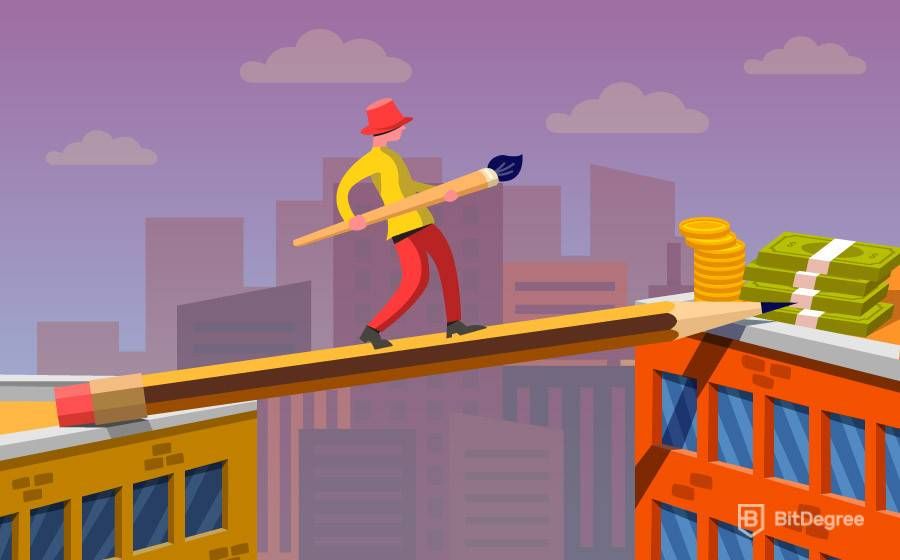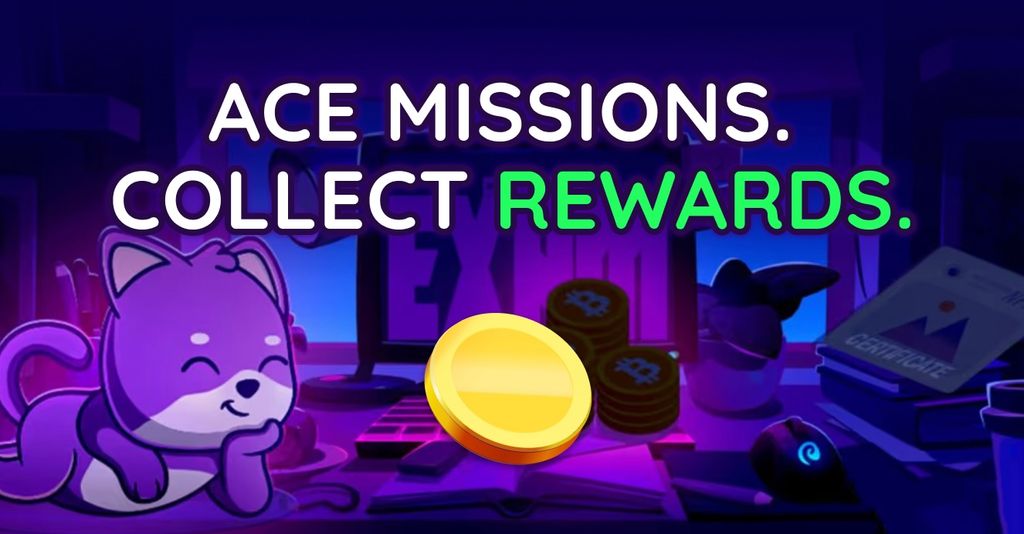Free Airdrop Season 7 is LIVE! Answer fun questions or do simple tasks to earn rewards from the $30K BitDegree prize pool. Participate Now ! 🔥
If you spend a good portion of time within online art-based communities, you might have noticed that the graphic design job description has increasingly risen in popularity and became more sophisticated than before. A graphic design career is something that many artists strive for - it sounds like a dream come true, being able to express your ideas, make them a reality and get paid for doing so. Surely, things are a bit more complicated than that, but it’s still an awesome career path to follow.
Before you go looking for graphic design jobs, however, there are a few things that you need to keep in mind. Do you already know what type of job you’re going to look for? Or what each of the different types of graphic designers does for their daily tasks? No need to worry - you’ll have the ability to learn these and many more things, all by reading this article!
Table of Contents
- 1. Responsibilities of a Graphic Designer
- 2. Different Types of Graphic Designers
- 3. Entry-Level Graphic Designers
- 3.1. Requirements
- 3.2. Responsibilities
- 3.3. Career Path
- 3.4. Salary
- 4. Junior Graphic Designers
- 4.1. Requirements
- 4.2. Responsibilities
- 4.3. Career Path Options
- 4.4. Salary
- 5. Senior Graphic Designers
- 5.1. Requirements
- 5.2. Responsibilities
- 5.3. Career Path Options
- 5.4. Salary
- 6. Conclusions
Responsibilities of a Graphic Designer
It is fairly possible that every graphic designer's job description is going to be different. The daily work that these people put almost always depends on the graphic designer. This could be seen as one of the biggest perks of the job - hours, responsibilities and workload depend on the specialist itself.
Latest Deal Active Right Now:Follow the Datacamp promo code link & get an exclusive 25% OFF Datacamp subscriptions. Act now while the offer is still available!
The graphic designer is responsible for the visual versions of brands, communications, and messages. One of the main goals is to create an effective visual message that would be easy to memorize, aesthetical and pleasing to the consumer's eye.
Usually, the graphic designer’s responsibilities look like this:
- Designing art for branding and communication purposes.
- Meeting client’s expectations on what they want out of a project, helping them to realize their ideas in a workable way.
- Working as a team member in designing a particular design, or completing a small portion of a big project.
- Creating ideas to solve the customer’s needs.
- Creating and managing a team of illustrators, photographers, or even writers for a project.
- Always being ahead of new software when it comes to graphic design related material.
Different Types of Graphic Designers
Same as most other career paths out there, graphic design job descriptions are usually segmented into three big groups that are based on the employee's skill level. The three groups are entry-level (otherwise known as a beginner), junior and senior graphic designers. All of these groups have different requirements, responsibilities, salaries, and so on. Now, let’s cover each of the groups one by one, starting with the entry-level graphic designer job description.
Entry-Level Graphic Designers
If you’ve graduated from a college or a university (or art academy) and have just received your graphic design diploma, congratulations - you’re a beginner graphic designer! Well, probably - some people who graduate will have already worked in multiple jobs based on graphic design. But let’s concentrate on the majority.
The main two things that define entry-level graphic designers are a lack of experience and still not knowing whether or not graphic design is the path for them. Beginner designers also have very limited knowledge when it comes to their professions - even though they might have finished a university and have higher education in graphic design, the lack of actual, real-life experience is surely the main problem that these people aim to address.
Requirements
When it comes to the entry-level graphic design job description, their requirements are usually pretty low. When an employer is looking for a beginner graphic designer, they usually know that this person is going to have to do a whole lot of learning. That’s why many companies that choose to hire entry-level graphic designers offer a comparatively low salary, but provide a great opportunity to gain experience and grow as a professional of your craft.
If you’re a complete beginner and want to find a job that would help you build a foundation and train your skills, one of the very first requirements that you will most likely face is going to be formal education. Most workplaces require graphic designers to have graduated from a college or a university and have a degree in Graphic Design.
A lot of people today, however, turn towards alternative learning methods (i.e. certified online courses). If graphic design is something that you’re truly passionate about, but for some reason, you can’t or don’t want to study in a formal education-providing institution, then e-learning might be the way to go!
Whatever you choose to do with your education, one thing’s for certain - your accumulated portfolio is going to be the single most important aspect of your job interview. This isn’t only true when it comes to graphic design job descriptions, however - every single profession that has to do with art in one way or another will require you to have a good portfolio of your best past work. Moreover, these days you can even get a scholarship to help you pay for the online course, so there's really nothing stopping you.
Just to show you how important this is, let me put it this way: you can have zero experience and no formal education, whatsoever - if you’re portfolio is amazing, you will get the job, end of the story.
Talking about some of the more traditional requirements for entry-level graphic design jobs, you will find that most graphic designer job descriptions stress the importance of being able to work in a team and communicate your ideas to your colleagues, work with clients to reach a shared consensus, be patient and have a good mentality, etc. All of these criteria are important, and they will be the deciding factors between you advancing further on the graphic design career path, or turning somewhere else.
Responsibilities
As for beginner graphic designer job description, your primary responsibility is to know and understand what do graphic designers do and how they work in an everyday fashion. You have to be able to find your rhythm and pace within your new company as soon as possible - this will show your new employers that you are motivated to advance to the next level ASAP.
Entry-level graphic designers should be attentive, hard-working and passionate about what they do. You should also be able to perform some of the most basic of tasks that are associated with graphic design jobs (communicating with the client, sketching out multiple design ideas, etc.).
Career Path
Beginner graphic design job descriptions don't offer many possibilities at the very beginning. However, if we were to look at the broader picture, the graphic design offers a lot of awesome career choices as his career progresses. As you gain experience and grow within the company, you’ll unlock a better salary, more job benefits, and so on.
What many people don’t consider, however, is that graphic designers have the option to work as freelancers. This is a rather popular graphic design career path, especially for people who already have a grasp on their own, personal styles. There are certain pros and cons to being a freelance graphic designer, though! Even though you get to “be your own boss” and dictate your salary rates, it can be tough finding potential clients in the very beginning. Furthermore, if you want to be truly successful in the freelance graphic design career path, you’ll have to have a very strict discipline!

- Easy to use with a learn-by-doing approach
- Offers quality content
- Gamified in-browser coding experience
- Free certificates of completion
- Focused on data science skills
- Flexible learning timetable

- High-quality courses
- Nanodegree programs
- Student Career services
- Nanodegree programs
- Suitable for enterprises
- Paid certificates of completion

- A wide range of learning programs
- University-level courses
- Easy to navigate
- University-level courses
- Suitable for enterprises
- Verified certificates of completion
Salary
It would be impossible to calculate the salary of freelance graphic designers since every single one of them has their rates. That’s why we’ll stick to the designers who work in official job positions.
According to Payscale.com, the average annual salary that entry-level graphic design job descriptions offer should be around $40,700. Keeping in mind that we’re talking about the very beginners here, that’s a pretty good salary!
Junior Graphic Designers
Junior graphic designers are your most commonly-encountered specialists out of the three groups mentioned in this tutorial. These designers are usually defined as people who already have some experience with graphic design jobs, and are now working towards becoming senior members of their respective teams.
Requirements
To become a junior graphic designer, you have to be able to work on your own. And no, I don’t mean freelancing - what I'm talking about is the ability to perform your given tasks within the company without the need for constant supervision. This is a huge difference between the beginner graphic designers and their junior colleagues - while beginners need to be guided and supervised, junior designers should be able to work individually, with their work checked periodically.
Naturally, the above-stated requirement comes as an addition to the ones that are mentioned in the beginner graphic design job description. Same as beginners, junior designers should also have proper education, great communication skills, an outgoing personality and so on.
Skill-wise, most junior graphic designer job descriptions mention that these people should be able to work with the common tools associated with graphic design, deal with clients, develop various graphics, etc.
Responsibilities
Knowing what do graphic designers do isn’t going to be the only responsibility that you’ll have. That being said, responsibilities associated with junior-level graphic design jobs are still pretty straightforward - they depend solemnly on the company that you’re working for, but most of them involve dealing with some common, every-day tasks. In this skill level, you can expect to get some more difficult and time-consuming tasks to test your skills and attitude. You won’t receive the most difficult tasks, though - those are reserved for the senior group of graphic design jobs.
Career Path Options
Junior graphic design job descriptions offer a lot of different options to pick from. Since it is already assumed that you have some relevant experience of working with graphic design, a lot of different companies might want to (or agree to) hire you. It all kind of depends on the route that you want to take. Some people tend to enjoy the marketing and business side of graphic design, while others prefer to stay closer to their art. Whatever the case might be, you should be able to find suitable jobs without too much struggle.

- Easy to use with a learn-by-doing approach
- Offers quality content
- Gamified in-browser coding experience
- Free certificates of completion
- Focused on data science skills
- Flexible learning timetable

- High-quality courses
- Nanodegree programs
- Student Career services
- Nanodegree programs
- Suitable for enterprises
- Paid certificates of completion

- A wide range of learning programs
- University-level courses
- Easy to navigate
- University-level courses
- Suitable for enterprises
- Verified certificates of completion
Salary
You would think that the junior graphic design job descriptions offer a salary that can be used to determine the average overall salaries that graphic designers get, right? Well, things are a bit more complicated than that. It would make sense - since the junior group is in the middle between beginners and senior designers, it would seem fair to assume that their salary is also “in the middle”.
But you see, there are a lot of different junior graphic designers out there - some of them are closer to the beginner group and have just learned what do graphic designers do, while others are one step away from being appointed as senior designers. And still, both of these designers would fall under the umbrella of the “junior” title. They wouldn’t make the same salary, though! This is why the salary that junior-level graphic design job description offers very volatile and prone to constant change. Keep that in mind!
As of writing this article, however, Glassdoor.com states that the average yearly salary of a junior graphic designer should be around $45,500. Not bad!
Senior Graphic Designers
This is probably the most self-explanatory group of designers out there - senior graphic designers are the top-dogs of the industry. These people are the leading experts in their field, and they are the ones that both set the trends, and then dictate them afterward. Naturally, it is also the group that has the most requirements and responsibilities out of them all.
Requirements
Senior graphic design job descriptions will require you to have a thorough understanding of not only the tools used in graphic design but of the whole concept of this profession, in general. In order to get a job as a senior graphic designer, you are going to have to be an expert in communicating your ideas to other people, understanding your client’s wants and needs, be able to prepare multiple top-notch design ideas, guess what is going to be popular within the industry in the upcoming months, and so on.
Responsibilities
Senior graphic designers are responsible for quite a few different things. As with most jobs out there, if you’re an expert in what you do, you are most likely going to be asked to share your knowledge with company newcomers.
The same thing applies to graphic design, too - you’ll have to spend a good portion of your time teaching beginner and junior graphic designers all of the tropes of the industry, and making sure that they unlock their full potential as soon as humanly possible.
The most difficult part of a senior graphic designer job description is that you’ll have to balance mentoring other people with your work. And this work isn’t going to be easy, either! On the contrary - senior graphic designers work on some of the most difficult tasks out there!
Career Path Options
Senior graphic design career path-wise, you’ll have three huge choices in front of you. First of all, you can simply work in a company - that’s pretty straightforward. On the other hand, you could follow the path of freelancing. It’s a much more risky career path to take, but it can be tempting - huge salaries defined only by you, freedom to choose your timetable, etc.
Finally, you could manage both of those options together and work both in a company and on your own, individual projects simultaneously. While this isn’t for everyone, some senior graphic designers might find that it’s the optimal route to take.

- Easy to use with a learn-by-doing approach
- Offers quality content
- Gamified in-browser coding experience
- Free certificates of completion
- Focused on data science skills
- Flexible learning timetable

- High-quality courses
- Nanodegree programs
- Student Career services
- Nanodegree programs
- Suitable for enterprises
- Paid certificates of completion

- A wide range of learning programs
- University-level courses
- Easy to navigate
- University-level courses
- Suitable for enterprises
- Verified certificates of completion
Salary
According to GlassDoor, in the senior graphic designers' job description you can expect up to around $59,400 earnings per year. Keep in mind, though, that this is the base pay - different jobs may offer different benefits, and if you choose to also freelance, this number can increase by quite a bit!

Did you know?
Have you ever wondered which online learning platforms are the best for your career?
Conclusions
So - now you know a whole lot more about the different graphic design jobs that are out there. I wish you all the best of luck in your future career path, and hope that this article was informative and useful!











